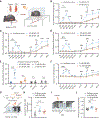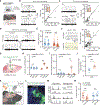Sound induces analgesia through corticothalamic circuits
- PMID: 35857536
- PMCID: PMC9636983
- DOI: 10.1126/science.abn4663
Sound induces analgesia through corticothalamic circuits
Abstract
Sound-including music and noise-can relieve pain in humans, but the underlying neural mechanisms remain unknown. We discovered that analgesic effects of sound depended on a low (5-decibel) signal-to-noise ratio (SNR) relative to ambient noise in mice. Viral tracing, microendoscopic calcium imaging, and multitetrode recordings in freely moving mice showed that low-SNR sounds inhibited glutamatergic inputs from the auditory cortex (ACxGlu) to the thalamic posterior (PO) and ventral posterior (VP) nuclei. Optogenetic or chemogenetic inhibition of the ACxGlu→PO and ACxGlu→VP circuits mimicked the low-SNR sound-induced analgesia in inflamed hindpaws and forepaws, respectively. Artificial activation of these two circuits abolished the sound-induced analgesia. Our study reveals the corticothalamic circuits underlying sound-promoted analgesia by deciphering the role of the auditory system in pain processing.
Conflict of interest statement
Figures




Comment in
-
Sounding out pain.Science. 2022 Jul 8;377(6602):155-156. doi: 10.1126/science.add0640. Epub 2022 Jul 7. Science. 2022. PMID: 35857551
Similar articles
-
Cross-modal cortical circuit for sound sensitivity in neuropathic pain.Curr Biol. 2025 Feb 24;35(4):831-842.e5. doi: 10.1016/j.cub.2024.12.044. Epub 2025 Jan 30. Curr Biol. 2025. PMID: 39889698
-
Sounding out pain.Science. 2022 Jul 8;377(6602):155-156. doi: 10.1126/science.add0640. Epub 2022 Jul 7. Science. 2022. PMID: 35857551
-
Parallel Processing of Sound Dynamics across Mouse Auditory Cortex via Spatially Patterned Thalamic Inputs and Distinct Areal Intracortical Circuits.Cell Rep. 2019 Apr 16;27(3):872-885.e7. doi: 10.1016/j.celrep.2019.03.069. Cell Rep. 2019. PMID: 30995483 Free PMC article.
-
Role of auditory-somatosensory corticothalamic circuit integration in analgesia.Cell Calcium. 2023 May;111:102717. doi: 10.1016/j.ceca.2023.102717. Epub 2023 Mar 12. Cell Calcium. 2023. PMID: 36931195 Free PMC article. Review.
-
Lemniscal Corticothalamic Feedback in Auditory Scene Analysis.Front Neurosci. 2021 Aug 19;15:723893. doi: 10.3389/fnins.2021.723893. eCollection 2021. Front Neurosci. 2021. PMID: 34489635 Free PMC article. Review.
Cited by
-
Exploring combat stress exposure effects on burn pain in a female rodent model.BMC Neurosci. 2022 Dec 6;23(1):73. doi: 10.1186/s12868-022-00759-z. BMC Neurosci. 2022. PMID: 36474149 Free PMC article.
-
Thalamocortical Mechanisms Underlying Real and Imagined Acupuncture.Biomedicines. 2023 Jun 26;11(7):1830. doi: 10.3390/biomedicines11071830. Biomedicines. 2023. PMID: 37509469 Free PMC article.
-
The psychotomimetic ketamine disrupts the transfer of late sensory information in the corticothalamic network.Eur J Neurosci. 2023 Feb;57(3):440-455. doi: 10.1111/ejn.15845. Epub 2022 Nov 1. Eur J Neurosci. 2023. PMID: 36226598 Free PMC article.
-
Effect of music intervention on subjective scores, heart rate variability, and prefrontal hemodynamics in patients with chronic pain.Front Hum Neurosci. 2022 Nov 17;16:1057290. doi: 10.3389/fnhum.2022.1057290. eCollection 2022. Front Hum Neurosci. 2022. PMID: 36466624 Free PMC article.
-
Characterization of Anxiety-Like Behaviors and Neural Circuitry following Chronic Moderate Noise Exposure in Mice.Environ Health Perspect. 2023 Oct;131(10):107004. doi: 10.1289/EHP12532. Epub 2023 Oct 5. Environ Health Perspect. 2023. PMID: 37796530 Free PMC article.
References
-
- Gardner WJ, Licklider JC, Weisz AZ, Science 132, 32–33 (1960). - PubMed
-
- Keenan A, Keithley JK, Oncol. Nurs. Forum 42, E368–E375 (2015). - PubMed
-
- Nguyen TN, Nilsson S, Hellström A-L, Bengtson A, J. Pediatr. Oncol. Nurs 27, 146–155 (2010). - PubMed
-
- Hartling L et al., JAMA Pediatr. 167, 826–835 (2013). - PubMed
-
- Boyd-Brewer C, McCaffrey R, Holist. Nurs. Pract 18, 111–118 (2004). - PubMed
MeSH terms
Grants and funding
LinkOut - more resources
Full Text Sources
Other Literature Sources
Medical

